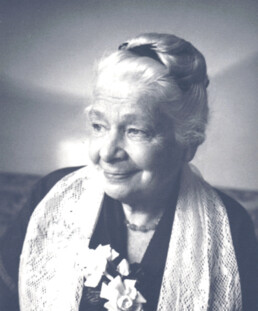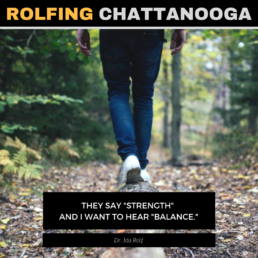What is Fascia & Myofascial Release?
Fascia and myofascial release are becoming common terms. But are they worth paying attention to? Let us take a deeper look at what fascia is and how fascia can affect your body. We will also delve into the field of manual therapy called myofascial release. We will look at the goals of myofascial release and how they differ from other therapies.
What is Fascia:
Fascia is one type of connective tissue in your body. Fascia is not unique to human beings. All animals possess fascia. Fascia organizes cells, tissues, and in turn an entire body. Fascia runs from head-to-toe weaving every muscle, bone and organ together. Your fascia is the organ of structure. Its framework is both protective and supportive. Their is no beginning or end to your fascia system, which is arranged in layers throughout the body.
In a healthy body the fascia can glide and deform with ease. This allows for easy flexible movement without restriction. Fascia also creates stability by reenforcing joints and load bearing chains within the body. One type of fascia surrounds nerves and blood vessels allowing them to slide through tunnels and across joints.
Our fascia is constantly growing and adapting to our physical needs. Another type of fascia is involved with wound healing. A scaffold of fascia is deposited by special cells called fibroblasts over the site of injury. Immune cells and others use this scaffold as substrate for healing. Fascia is composed of fibers, cells, and fluid matrix or ground substance. Depending on the proportions of each, fascia takes on differing qualities ranging from dense to loose and can be highly structured or irregular. Dense ordered fascia is found in the strong linear bands of tendons and ligaments. Loose irregular fascia can be located underneath the skin and as padding around organs.
Over time fascia can become too thick and too dense to allow proper movement. This is especially common following an injury, think scar tissue, but can also occur due to body mechanics and stress. Inflammation and disease negatively impact the fascia as can smoking and poor diet. Joints may become tight not because a muscle is tight but because the fascia surrounding the muscles does not allow enough space. Because fascia is everywhere its effects are often far reaching.
Fascia is Plastic:
Fascia’s greatest strength lies in its adaptability. Although the exact mechanism is debated, it is recognized that fascia changes when appropriately contacted. This may feel like melting, stretching and gliding. Tissues under contact soften and find length. Areas of dense tissue differentiate into separate bundles which can then be further divided. Using finger tips, knuckles or an elbow, the therapist aims to separate layers of fascia. A treatment may involve active or passive participation of the client.
Fascia that was stiff, bound, or painful regains movement and hydration. Joint decompression relieves misalignments and permits more efficient transfer of force along the bone axis. Nerves, blood vessels and arteries regain an ability to elongate as the joint rotates.
What is Myofascial Release?
Myofascia is a particular type of fascia that surrounds muscles. Its thin and strong fibers may have a tensile strength of more than 2000 pounds. Fibers surround individual muscle cells bundling them into functional units. Injury, inflammation, and disease may cause myofascia to contract and loose hydration. The end result is reduced mobility, pain, or structural misalignment. Contracted myofascia is called a restriction. You may feel them as knots or tight bands of tissue. But remember, this same tissue extends deep into the joints.
Myofascial release is a manual therapy targeted at tight restricted myofascia. The therapist generally uses deep sustained pressure with the goal of mobilizing the bound layer. Myofascial release can be a little uncomfortable at first but often leads to a deep sense of relaxation. This is due to changes at the level of your nervous system. Much myofascial work is done close to bones and joints. In these areas the fascia is particularly susceptible to hardening and they can be the more difficult to access through traditional approaches.
There are many products on the market sold to help you perform self myofascial release. These vary from hard and soft foam rollers to balls and the like. Many of them can do a lot of good when used correctly. However, I believe there is no substitute for the precision achieved by a skilled myofascial therapist.
There are many schools and approaches to myofascial release. Many are based on the pioneering work of Dr. Ida Rolf. When considering which therapist it is best for you, ask if they have experience with your particular condition. An ability to achieve your treatment goals should be your primary criteria. Often treatment will take multiple sessions, so it is wise to plan ahead.
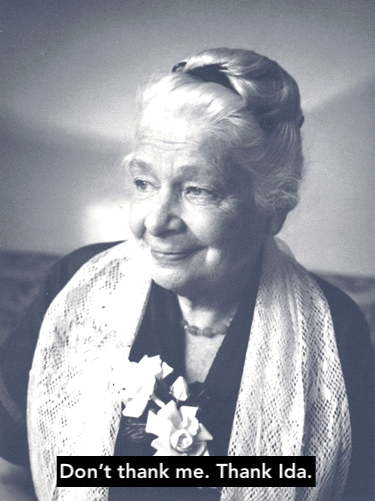
How is Myofascial Release Different?
The effectiveness of myofascial release comes from your bodies own natural intelligence. In myofascial release we are not creating anything new. Instead we return your body to its naturally balanced state. Do you remember what it felt like to move as a child? Your body was built around this ease. But we take some knocks along the way and those stresses are maintained by the myofascia. In myofascial release the objective is to free bound tissue, effectively taking years off your body. The techniques are safe and very effective.
If your body is in a state of tension, conscious or otherwise, you experience a diminished quality of life. When you get into your car and drive, soon your forget all about the vehicle. The wheels become an extension of your hands, the radio an extension of your finger tip. But now the ride is no longer smooth and the reception is off. What you need is a proper mechanic to work on your vehicle. Only then will the driving experience match your expectations.
Immediately following myofascial release you may notice changes in how you feel and move. For example, it is common to have an increased range of motion. Over the next few days your body will be adapting to this change. Movement draws in fresh blood and removes a build up of metabolic waste. It is not uncommon to feel a little muscle soreness, but this is temporary.
Ida Rolf compared this work to making a bed. She said, “Rolfing can be like making your bed in the morning. You think you’re going to get by without pulling that bed apart, so you pull up this cover and the next cover. When you get all the covers puffed up, you’ve got nine ridges running across the bed. Now you’ve got to go to a deeper layer and organize the deeper layer, and make your bed on top of that. Then you’ve got a made bed. Well it’s the same with the body: you’ve got to organize those deeper layers.”
Myofascial release is one way of organizing the deeper layers of the body so that superficial surface layers regain their natural position and organization. To make the example more concrete consider the shoulder joint. Strong deep muscles of the rotator cuff create stability. Superficial muscles generate movement, strength and power. Proper functioning requires both layers to be unrestricted.
Benefits of Myofascial Release:
Myofascial release is beneficial in treating, managing and eliminating many common physical conditions. How can you tell if myofascial release is right for you? Ask yourself these questions: Does my body feel tight? Can I no longer move as well as before? It may be hard to find somebody who does not answer ‘yes’ to these questions. But this only points to the need for this beneficial work. Myofascial release is particularly useful where there has been an injury. At Rolfing Chattanooga, I commonly help clients recovering from car accidents and surgical procedures such as hip replacements. Many clients are also under care of a physical therapist or personal trainer. Myofascial work can also help to prevent injury and further physical decline.
Benefits:
Improved mobility
Improved stability
Reduced pain
Improved balance
Increased proprioception
Some Conditions Benefited by Myofascial Release:
Neck & Back pain
Sciatica
Scoliosis
TMJ and Jaw pain
Tunnel syndromes such as carpal tunnel
Nerve pain and problems affecting the extremities
Tennis & Golf Elbow
This list is just the starting point. In over five years of practice I have really seen it all!
Is Myofascial Release Scientifically Supported?
The good news is that myofascial release is scientifically and medically supported, but there is a lot more research left to do. Many studies are limited in size or complexity of design. It is also often difficult to determine how a result is achieved. In many regards the medical community is only beginning to understand the far reaching effects of myofascial therapy. Recent reviews point broadly at positive outcomes (McKenny et al, 2013). Myofascial instructor and Rolfer Til Luchau points out that, “Even if there is still disagreement about the exact mechanism involved, there is ample empirical and research-based evidence that manual therapy can increase fascial flexibility and adaptability, and that client benefits include increased mobility and less pain” (Luchau. Advanced Myofascial Techniques. p. 19. Handspring Publishing 2015).
Organizations such as the Fascial Research Congress (fasciacongress.org) aim to foster understanding and collaboration among scientists working in fascia research and clinical professionals whose work addresses fascia. Their work supports modern research and dissemination of the latest clinical findings.


McKenney, Kristin, et al. “Myofascial Release as a Treatment for Orthopaedic Conditions: A Systematic Review.” Journal of Athletic Training, National Athletic Trainers Association, 2013, www.ncbi.nlm.nih.gov/pmc/articles/PMC3718355
What is Rolfing Structural Integration | Rolfing Chattanooga

What is Rolfing, and can Rolfing help with this? These are questions I hear all the time. Rolfing Structural Integration (SI) is a type of hands-on bodywork that has many lasting benefits. Rolfing SI can reduce pain and is proven to improve posture. Rolfing SI leads to greater body awareness, increases balance and stability, and is a powerful way to address structural misalignment. Perhaps best of all, Rolfing SI is suitable for every body! As an approach to health, Rolfing is different from other bodywork you may be familiar with. Let us take a closer look.
Structural Integration is a process that brings separate parts of the body into equal balance. Health is the natural and inevitable consequence of a balanced and unified body.
How is Rolfing Structural Integration Different:
Typically, manual therapists direct their attention to the muscles. After all, most clients will make an appointment because they are experience muscle pain, muscle strain, or muscular tension. At first glance, working on muscles makes a lot of sense. After all, a good massage can do wonders! But all to often the symptoms return after a few days and you are forced to make another appointment. This back and forth may have you thinking that you are beyond help. I want you to know there is another solution and it is the holistic organization achieved by Rolfing Structural Integration!
- Fascia produces shape and physical organization.
- Most importantly fascia is
- absolutely everywhere.
 The shoulder pain you are experiencing may not be due to tight muscles, and your back spasm may not be caused by stuck joints. So we must ask, is there another system in the body that includes both muscles and bones? Yes, there is! It is the called the fascia. If you are a meat eater you know fascia as the weblike sheets and fibers surrounding muscles tissue.
The shoulder pain you are experiencing may not be due to tight muscles, and your back spasm may not be caused by stuck joints. So we must ask, is there another system in the body that includes both muscles and bones? Yes, there is! It is the called the fascia. If you are a meat eater you know fascia as the weblike sheets and fibers surrounding muscles tissue.
Fascia forms sheets and layers within the body and these function like a bags. A bag is responsible for holding and shaping its contents. For us, we can imagine the body as a series of bags within bags, and those bags are all fascia! Sheets and bags are a great way to create an orderly arrangement. Look around and you will see this idea everywhere.
Muscle tissue on its own is just a bunch of goo, it has no structure. As your body has a boney skeleton, muscles have a fascial ‘skeleton’ called myofascia (myo means muscle). As a whole, myofascia separates individual muscle fibers from one another. Other fascia delineates muscles from other tissues such as bones, nerves, arteries, and the organs. Fascia produces shape and physical organization. Most importantly fascia is absolutely everywhere.
What is important to realize is that fascia is the Organ of Structure. Size, shape, and deformation of fascia directly affects the structural organization of your body.
Try this experiment right now to understand. Take ahold of your shirt towards your waistline. Now start twisting and bunching up the fabric until you feel it tighten around your body. What do you notice? Is the sensation localized or does it spread? Can you feel tightness spanning your chest, your shoulders? What if you try to twist and bend? In this experiment you have not done anything to change the contents of your body. Instead you affected the boundary layer, the bag that you are within.
 Health is the natural and inevitable consequence of a balanced and unified body.
Health is the natural and inevitable consequence of a balanced and unified body.
In a healthy body, fascia allows movement without restriction and stability without rigidity. However, injuries, surgeries, and some movement patterns cause a restructuring of the fascia into shapes that limit mobility, cause painful conditions, and limit your sense of well-being. Think back a moment to the example with your shirt. What happened when you let go? After a bit of straightening out did everything return to normal? Yes it did! This is because your shirt was deformed but you were not. Rolfing Structural Integration works by releasing the layers of fascia naturally allowing the body to reorganize and to heal.
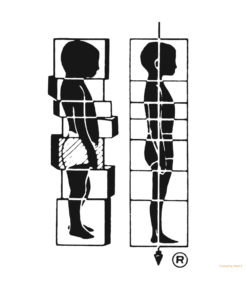 These organizational properties of the fascia were first recognized by Dr. Ida Rolf. She noticed that conditions of disease often presented as the body acting as separate parts instead of a unified whole. This concept is illustrated in the logo of the Rolf Institute.
These organizational properties of the fascia were first recognized by Dr. Ida Rolf. She noticed that conditions of disease often presented as the body acting as separate parts instead of a unified whole. This concept is illustrated in the logo of the Rolf Institute.
Dr. Rolf called her work Structural Integration. Integration is a term we are seeing in many aspects of modern health care. The term originates from latin, integrat – meaning ‘made whole’. Structural Integration is a process that brings separate parts of the body into equal balance. Health is the natural and inevitable consequence of a balanced and unified body.
In five years of practice I have seen amazing transformations achieved through Rolfing Structural Integration. Conditions such as poor range of motion, plantar fasciitis, sciatica pain, neck pain, and nerve pains respond very rapidly. Although reducing pain is not an objective of Rolfing it is a very common side effect. What is most exciting about Rolfing SI is that the results really do last. The positive effects of Rolfing are scientifically supported by peer reviewed studies. New research from the Harvard Medical School indicates that in combination with outpatient rehabilitation that Rolfing SI is likely to result in significantly greater improvement in the case of back pain without adverse effect.
As a process, Rolfing SI is a combination of manual bodywork and somatic education. I like to think of it as an overhaul for the body and lessons on movement that you never had growing up. Structural Integration is typically achieved through a series of ten sessions spaced one to two weeks apart. We call this the Rolfing 10-Series. Each session addresses an aspect of physical organization. Much like if you were repairing a house, you would first fix the foundation, then the walls (including electrical and plumbing), then the roof, and finally paint and place furniture.
Photo by Priscilla Du Preez on Unsplash
Photo by Dan Gold on Unsplash
Plantar Fasciitis Pain Stops Here
Plantar fasciitis is a common cause of heel pain and mid-foot pain that can make standing and walking unbearable. Individuals suffering with the symptoms of plantar fasciitis often struggle to find a lasting treatment. There are several causes of plantar fasciitis. Symptoms may develop gradually over time or may be a response to injury. Foot pain can be very disruptive and limiting to regular activities. Fortunately, plantar fasciitis often responds positively to Rolfing Structural Integration and Integrative Bodywork techniques.
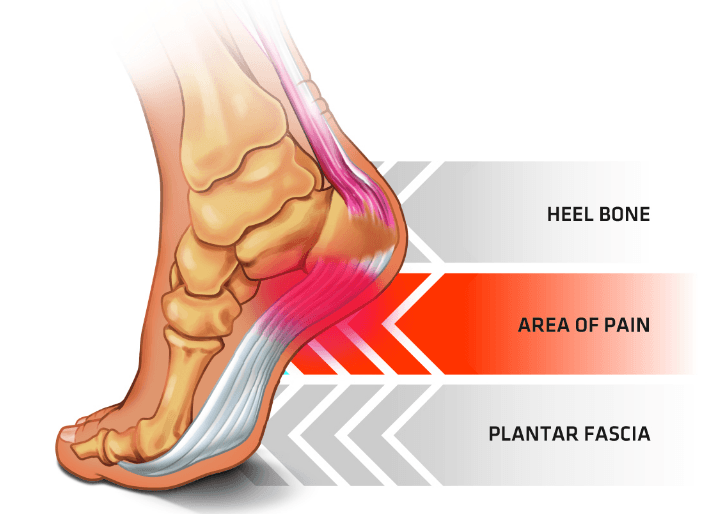
What Causes Plantar Fasciitis?
The plantar fascia is a layer of strong fibrous connective tissue located on the sole of the foot. Fasci-itis refers to an inflammatory reaction effecting this tissue. Pain may be felt at the heel or mid-foot area during palpation, standing, or in movement. The plantar fascia is a continuation of the posterior fascial line of the lower body. Past the heel, this layer becomes calf and then hamstring fascia before reaching the hips and low back. Due to the global connectivity of the body, plantar fasciitis can negatively impact the entire leg. Conversely, issues in the leg or even low back may produce pain similar to true plantar fasciitis.
Plantar fasciitis is caused by one of two phenomenon. In one situation, tension in the plantar fascia leads to formation of a heel spur. This abnormal boney protuberance creates irritation and is a source of pain. A far more common cause of plantar fasciitis is general muscular tightness and poor mobility.
Plantar Fasciitis Treatment:
Plantar fasciitis and heel pain generally respond rapidly to manual bodywork. When combined with Rolfing treatments and movement integration we have a truly powerful modality of care! Let us now look at a real example of how Rolfing techniques transformed a case of chronic plantar fasciitis.
Tammy’s story:
Tammy arrived for her first appointment with Dr. Eric at Rolfing Chattanooga with symptoms of chronic plantar fasciitis that was affecting both of her feet. She was previously diagnosis by her doctor and sent for physical therapy. Standing or walking for more than 30 minutes felt like an entire day of activity.Even light activity caused a severe increase in pain the next day. Tammy told me that her symptoms began three years ago after training for a 5k run. An inability to be on her feet made daily life challenging. Decreased activity contributed to weight gain. Physical therapy and chiropractic manipulations produced limited results. Tammy’s goal was to be able to walk without fear of next day pain and to participate in a kick boxing class.
“I had used inserts, sleep braces and actually had one foot in a cast and boot for 6-8 weeks. Nothing helped until Rolfing. Eric loosened up my legs and showed me that I was walking wrong. After 3 visit I can shop and enjoy life again.” Tammy, Soddy-Daisy, TN
I advised Tammy that she would need to come weekly for at least three sessions. We would use a combination of myofascial and Rolfing Structural Integration techniques. I told Tammy that even if she noticed major improvements after one session that it would be important to continue treatment to ensure that we are making a real change. Tammy agreed to three sessions and we began to work.
Knowing that Tammy’s pain began after training for a 5k run was a big clue that we were looking at a pattern of overuse and not a heel spur. Joint movement at the ankle and toes was reasonably good. Palpation of the plantar fascia revealed a few tender spots. Tammy added that her big toe also hurt at times. I moved my attention to her calves and the fascia of the lower leg.
Major movements of the foot originate from the lower leg. The leg is divided into four muscular compartments that are separated and organized by layers of fascia. The anterior and posterior compartments are responsible for flexing and pointing of the foot. Inside and outside compartments rotate and stabilize the foot.
Tammy’s muscles felt firm but lacked knots that are typically associated with an injury. When I moved her foot in and out of flexion it was hard to feel the corresponding action in the leg. This is the result of poorly differentiated fascial compartments. The sensation is of being bound up, like wearing a really tight sock.
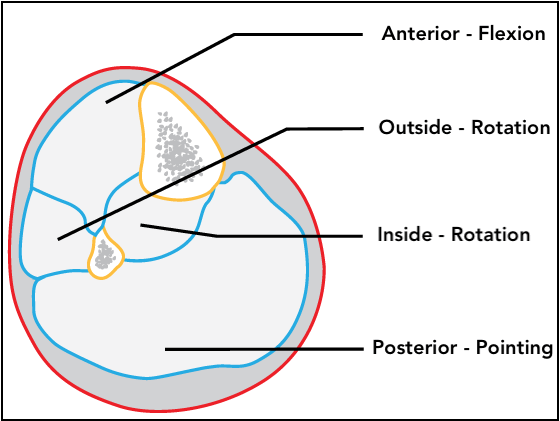
A cross-section of the lower leg reveals the arrangement of four muscular compartments delineated by (blue) fascia. Each compartment contains multiple muscles. (Yellow) The tibia and fibula; (red) skin boundary. Plantar fasciitis is often associated with tightness of the posterior compartment.
We began work on Tammy’s calves. I wanted pointing and flexing of the foot to be clearly visible in the lower leg. I wanted to be able to feel the muscular action in my hands. Finally, it was key that Tammy feel the different movements and to know where they originated from in her body. As the layers of fascia separated the range and ease of motion increased. Each foot felt more connected to its leg. Furthermore, each leg felt more connected to the entirety of Tammy’s body.
I asked Tammy to stand and walk around. She moved delicately as if balancing on feet that were too small for her body. In truth she was not using her whole foot to walk. I asked her what was missing. After a bit more walking Tammy declared, “my toes!”

An active toe hinge is critical for proper walking mechanics. After heel strike weight is transferred to the ball and toes of the foot. This stretches the plantar fascia and allows for proper kinetic movement throughout the foot, leg, and back.
When walking we should make full use of the bottom of the foot. This means landing on the heel and transferring weight to the ball of the foot and finally to the toes. When the bottom of the foot is irritated by symptoms of plantar fasciitis it is natural to adopt a new style of walking that reduces pain by minimizing use of the foot. Over time this strategy effects organization and tone of the leg. There can be major disturbances along the entire kinetic chain. I asked Tammy to be active with her toes by pressing them into the ground when walking. We practiced walking forwards and backwards to get a better feel for the toe hinge in movement.
Proper Shoes:
Tammy returned after one week for a follow up appointment. She had been walking more and actively using her toes. She said there was less pain on most days except for one. I asked how that day was different. She said she was wearing flip-flops around the house. Now, I don’t have anything against flip-flops but they are not appropriate for everybody. Tammy is a perfect example of how footwear can lead to downfall. She needs to utilize her toes more when walking but wearing flip-flops causes the exact opposite to occur. Instead, toes flex down to hold the thong. Control is enforced from the foot to prioritize “keep this shoe on” over “walk appropriately.” I told her, “the flip-flops have to go, at least for now!”

Tammy was looking forward to a road trip which would include a visit to New York City and lots of walking. This would be a great opportunity to test the effectiveness of the bodywork. We spent the session freeing the fascia relating to Tammy’s toes. This work has a major influence on the entire leg up to the hips. I made sure Tammy would be sitting in a comfortable supported position during the car ride. I asked her to take breaks from sitting to walk when possible. I also asked her to keep her legs and feet active when in the car by writing the alphabet with her feet.
Walking Back to Health:
At her third session, Tammy reports that she had a great vacation and did not experience any pain after walking for six hours. This is a very encouraging result and it seems like Tammy is well on her way to meeting her treatment goals! It is important at this time that Tammy get back to living without the fear of painful plantar fasciitis. She has done a great job at being an active responsible participant in her recovery. She does not need any encouragement to stay active.
Tammy’s legs are moving so much better than a few weeks ago. The muscle compartments are well defined. Good walking mechanics require adaptability in the bones of the lower leg. The tibia and fibula function as shock absorbers during each heel strike. Impact force transfers into a fascial structure called the interosseous membrane. We work this aspect of the legs which also requires opening the lateral knee.
Tammy’s walk has taken on a whole new character. Using the entire surface of her foot engages every aspect of the leg. The plantar fascia is no longer bound in the calves or held up at the toes. The bones of the lower leg allow a better transfer of force through the knee to femur and hip. This will reduce the chance of Tammy experiencing future knee and back pain.
Plantar Fasciitis Treatment – Conclusions:
It is important to know that your body is always able to heal. If you have plantar fasciitis I want you to know that Rolfing Structural Integration and Integrative Bodywork are very powerful approaches to recovery. Combined with simple natural movements and easy self care it is very possible to achieve a rapid and lasting recovery.
Please leave a comment if this article sparks your interest in Rolfing Structural Integration or Integrative Bodywork. You can also send me a direct message or schedule a consultation. I look forward to your recovery and well-being!
The Rolfing® Technique of Connective Tissue Manipulation
Structural Integration (SI) is a technique for reordering the body to bring its major segments — head, shoulders, thorax, pelvis and legs — toward a vertical alignment. Generally speaking, the Rolfing process lengthens the body, approaching an ideal in which the left and right sides of the body arc more nearly balanced and in which the pelvis approaches horizontal, permitting the weight of the trunk to fall directly over the pelvis; the head rides above the spine, the spine curves are shallow, and the legs connect vertically to support the bottom of the pelvis.
MAN DEALS WITH GRAVITY in a way different from other animals. Rather than planting himself firmly on four or more supports, he has swung himself up on a narrow, unstable two-point base; he is less secure but more dynamic, more flexible, with two of his limbs free for an active and mobile contact with his world. The tightrope walker presents this image of balance and lightness in ourselves, a delicate adaptability to the forces acting on us. Man’s center of gravity is high, giving him a state of high potential energy.
The key to this efficient and graceful relationship to the field of gravity is a body in which the weight transmission remains close to a vertical central axis. The amount of energy required to move weight around a vertical axis (the moment of inertia) decreases geometrically as the weight is moved toward the axis, as skaters and ballet dancers know when they achieve fast spins by pulling in their arms and legs and lengthening their bodies.
If we picture the body as a stack of partially independent weight segments, the least energy will be expended in rotational movement when the blocks are stacked directly above one another. This stacking will also result in the highest possible center of gravity since the spinal curves will be shallow and the body consequently longer.
THE AVERAGE INDIVIDUAL has let his body weight slip out from the vertical axis, that is, he has shortened his body. His head has slumped forward and his buttocks are probably carried up and back. Most likely his body has twisted as it has slumped; one shoulder or one hip may lead the other as he walks. Knees may track out or in and misaligned ankles may throw his weight to the outside of his feet. One foot probably carries more weight than the other.
How do bodies become unbalanced? From a purely mechanical perspective, distortions are the result of the remarkable plasticity of the body; the tendency of fascia, the connective tissue which envelops the muscles and which gives the body shape, to be remolded by applied force. The primary force comes from repeated patterns of self-use, the way an individual walks, sits or sleeps. These patterns, which are generally established in infancy, draw heavily on parental example and on the other environmental factors like diapers, shoes and school desks. Inefficient patterns of behavior set themselves in the fascial network as unbalanced patterns of structure.
Distortions also enter our plastic bodies through accidents: a fall from a bicycle, for example, that twists a knee, causing a limp for a few weeks. The shifting of weight to the strong leg restructures the play of muscular effort not only in the legs, but through the pelvis, up the spine, eventually throughout the whole body. Although the limp seems to disappear as the knee strengthens, the system of compensations leaves its imprint in a broad, complex pattern of shortened fascia.
Patterns of imbalance tend to reinforce themselves; they feel comfortable and natural — balanced, in fact. Over the years they deepen by repetition, and the weight centers more progressively further from the vertical axis. Gravity becomes an increasingly destructive force.
THE CONSEQUENCES OF IMBALANCE are surprisingly broad. When the body’s blocks, shifted in various directions out from the vertical axis, are no longer stacked on top of one another, both skeleton and musculature are forced into an inefficient weight-bearing function. For example, the head of the lady pictured in this article is no longer being: carried skyward by the cervical spine: instead; the muscles of the neck and upper back, designed as dynamic guide wires to move and balance the head, are forced into chronic tension required to support its weight.
The function of most muscles is to contract in order to bring about movement, to release in order to bring about movement, and then to release again in order to be prepared for new movement. When they consistently take on the weight-bearing function of bone, their fascial envelopes tend to take on the hard and inelastic quality of bone. Tightness spreads through the fascial network: the body- locks up and the joints lose their freedom.
Joints lose their ease of movement not only from the tightening of fascial planes which cross them, but also from the fact that as the two body parts that relate to one another through the joint lose the integrity,’ of their relationship_ the articulating surfaces of the joint itself do not meet in a way appropriate to their structure. If the bones of the lower leg, for example, are twisted outward and the bone of the thigh inward, a common situation_ the knee is likely to be a troublesome or unstable one. The movement of the leg – indeed of the whole body – will lack the grace which comes of movement that is appropriate to the structure. We are likely to call such movement “disjointed.- a sign of our intuitive understanding that it is not integrated.
Circulation is restricted as the body tightens because the vessels run in and through the fascial network. The depression of the upper chest, a consequence in part of the shifting forward of the head, limits abdominal and pelvic cavities, often impairing function. Swayback, for example, spills the abdominal viscera forward into a protruding abdomen, changing the spatial relationships between organs and the direction of pressures on them.
Bodies may also show imbalance of tonus between the voluntary musculature of the surface and the deeper, smaller, slower moving and more reflexive muscles such as those which lie around the spinal column, Inability to lengthen the spine because of tightened fascia will tend to throw the deeper muscles out of use, resulting in a jerky movement style which is neurologically imbalanced toward cerebral or voluntary control at the expense of the reflexive centers of the spinal cord.
The state of balance or imbalance in our bodies – their relationship to the field of gravity – is reflected in feeling states, since emotion is intimately involved with muscular tonus. Balance might be thought of in a healthy organism as a resting state, a capacity and a preparedness for responses of all kinds depending on the nature of the stimulus. Imbalance,
then, is the response itself – the movement, or impulse to movement, which completes itself by a return to balance when the response has spent itself. But our lives are such that many responses never do complete themselves. A child with a threatening mother, for example, may continually be shrinking away, lowering his head, raising his shoulders and depressing his chest until the pattern becomes a norm for him: or he may, like a racer waiting for a starting signal that never comes, build tension in his legs through an unfulfilled impulse to run away. The muscular tension and the emotion are two aspects of the same organic pattern.
Chronic muscular tension is a permanent shortening of fascial structures; to the extent to which they arc no longer capable of lengthening, they have built into the person not only a way of moving but a way of feeling, so that one particular kind of emotion characterizes his response to a wide range of stimuli. His response, then, is always in part to his past-to those strong influences in reaction to which his structural imbalances were developed. This programming marks a loss in his ability to respond with full appropriateness to present situations.
One individual may perceive his losing fight with gravity as a sharp pain in his back, another as the unflattering contour of his body, another as constant fatigue, yet another as an unrelentingly threatening environment. Those over 40 may begin to call it old age. And yet all these signals may be pointing to a single problem, so ubiquitous in their own structure as \ yell as in function that it has been ignored: they are off balance. They are all at war with gravity.
ROLFING SI REBALANCES the fascial network by taking advantage of its tendency to hold the shapes induced by applied force. In a carefully worked-out sequence of manipulations, the Rolfer reverses the randomizing influence of the environment, moving tissue back toward the symmetry and balance that the architecture of the body so clearly calls for.
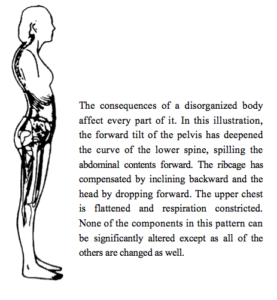 The consequences of a disorganized body affect every part of it. In this illustration, the forward tilt of the pelvis has deepened the curve of the lower spine, spilling the abdominal contents forward. The ribcage has compensated by inclining backward and the head by dropping forward. The upper chest is flattened and respiration constricted. None of the components in this pattern can be significantly altered except as all of the others are changed as well.
The consequences of a disorganized body affect every part of it. In this illustration, the forward tilt of the pelvis has deepened the curve of the lower spine, spilling the abdominal contents forward. The ribcage has compensated by inclining backward and the head by dropping forward. The upper chest is flattened and respiration constricted. None of the components in this pattern can be significantly altered except as all of the others are changed as well.
Consistent misplacement of weight anywhere in the body evokes a compensatory pattern of tightening throughout the fascial system. For example, the forward slump of the head of the lady in the illustration is directly related to the tilting of her pelvis and to the locking of her knees, to select only three parts from the pattern. Relief given by freeing either neck or knees alone would be temporary because other parts of the pattern would later force the relived part to function in harmony with them. For that reason the Rolling practitioner looks at the entire fascial structure and works to rebalance it.
Rolfing SI takes place in a series of ten sessions lasting about an hour each and usually spaced a week or more apart. It proceeds from the surface of the body toward deeper levels and from the relief of specific local areas of contraction and displacement in the first seven hours to the reorganization of the relationships between major segments of the body in the last three.
The Rolfer must apply sufficient force to stretch and move tissue, furthermore, he or she is frequently working in tissue whose chronic tension carries an emotional load. There may be some discomfort that disappears immediately when the pressure is removed. And there is sometime soreness, of the kind felt when muscles are overworked, that lasts a few days. Pain frequently marks an emotional release, and mad be strongly colored by associated emotions. People who are receiving Rolling SI often recall specific traumatic episodes associated with particular parts of the body: with or without such recall, the release of chronic contractions has an emotionally purgative effect. “I feel as though I have unloaded years of accumulated grief,” was the comment of one person who cried as tension was released from his ribcage.
THE RESULTS OF ROLFING SI are as varied and complex as the organisms being altered. Generally speaking, the body acquires a lift, or lightness as the head and chest go up and the trunk lengthens: the pelvis, in horizontalizing. brings the abdomen and buttocks in; the knees and feet track more nearly forward and the soles of the feet meet the ground more squarely. As the joints gain freedom the major segments of the body rotate and hinge more freely on one another. There is less pitching of the body from side to side in walking and less raising of the body weight with each step. Conserved energy is available for other purposes.
The lengthening and centering of the body along its vertical axis together with an increased engagement of the deep musculature brings a quieting, a flexible sense of self-possession that tends to replace earlier pre-structured responses. Since this new sense of self is presented to others in the carriage of the body, even casual social contacts may seem altered: increased self- trust communicates itself as trust-worthiness.
The long-range consequences of Rolfing SI vary a great deal, since the body continues to be plastic and therefore subject to forces around and within, both constructive and destructive. Most people undergo a spontaneous integration process for
at least a year after their Rolfing sessions as their improved balance manifests itself throughout the body. Especially if a conscious effort is made to replace old destructive habits of self-use, structural changes tend to bring about behavioral changes as people use new, more balanced patterns of movement and meet situations with less tension. Many people have experienced a striking reversal when a vicious cycle of energy drain and structural break down has been replaced by progressive self-enhancement. After a period of months or years some people may wish to return for further sessions, including the advanced series.
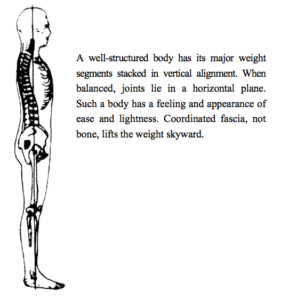 RESEARCH on Rolfing SI has provided objective quantitative data about its effects. As early as the 1970s, Dr. Valerie Hunt, Director of the Movement Behavior Laboratory at UCLA and Dr. Julian Silverman, Research Specialist of the California Department of Mental Hygiene, conducted experiments at Agnew’s State Hospital in which subjects were tested before and after Rolfing Si sessions for changes in neurological control of the muscles, for variation in responses to stimuli, and for biochemical changes. Their findings indicated that after Rolfing work, there was a more efficient use of the muscles, conserved energy, increased refinement of response and a tendency for motor control to shift toward the more reflexive spinal centers.
RESEARCH on Rolfing SI has provided objective quantitative data about its effects. As early as the 1970s, Dr. Valerie Hunt, Director of the Movement Behavior Laboratory at UCLA and Dr. Julian Silverman, Research Specialist of the California Department of Mental Hygiene, conducted experiments at Agnew’s State Hospital in which subjects were tested before and after Rolfing Si sessions for changes in neurological control of the muscles, for variation in responses to stimuli, and for biochemical changes. Their findings indicated that after Rolfing work, there was a more efficient use of the muscles, conserved energy, increased refinement of response and a tendency for motor control to shift toward the more reflexive spinal centers.
Over the decades, research has continued, looking at the effects of Rolling SI on cerebral palsy in both adults and children, the treatment of chronic pain, the treatment of cervical spine dysfunction, improvement in balance, the treatment of chronic fatigue syndrome. as well as effects on anxiety and other psychological reactions.
Other research is planned or in progress; please visit www.rolf.org/research for current information.
DR. IDA P. ROLF (1896-1979), originally an organic chemist with the Rockefeller Institute, perfected the process of Rolfing Structural Integration over many years before establishing a systematic training program and a professional organization. Nearly 1900 Certified RolfersTM and Rolf Movement® practitioners are located throughout the world. Training programs are currently conducted in the United States, Europe, and Brazil with regional offices also in Australia, Canada and Japan.
To find Certified Rolfers and Rolf Moment practitioners in your local area, please visit the website at: http://find.rolf.org
Feel free to contact us with any questions at:
The Rolf Institute® of Structural Integration
(303) 449-5903 / (800) 530-8875 Fax (303) 449-5978 [email protected]
Rev. 10/2012
© Copyright 1976, 2003, 2012 by The Rolf Institute®. All rights reserved. “RolferTM,” Rolfing®,” “Rolf Movement®,” “The Rolf Institute®,” and Little Boy Logo are all servicemarks of The Rolf Institute. They can only be used by licensed members in good standing of The Rolf Institute.
Get reconnected.
Nature offers an opportunity to rest in the present moment free from distractions. Nature is always creating, sustaining, and renewing – without cause or need. Nature can be found inside your home, on your doorstep, and within your heart. The next time you need anything, rest for a moment in nature and see what happens.
Image shared from www.forestethics.com


